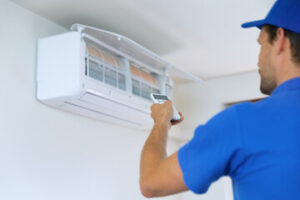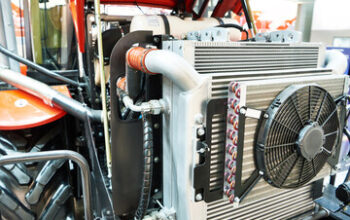Cincinnati Air Conditioning is one of the most ubiquitous technologies in modern society. It cools and conditions the air, and it also dehumidifies.
The key to the technology is a chemical called refrigerant (usually Freon). Refrigerant converts from liquid to gas and back again in a cycle.
The technology is housed in two units: a condensing unit located outside and the indoor evaporative air conditioning unit.
While most homeowners don’t think much about refrigerant until something goes wrong, the chemical is actually an integral part of air conditioning. Refrigerant is what keeps your house cool and helps the process of evaporation and condensation work as it should. Without it, you wouldn’t have a working air conditioner.
The chemistry behind this chemical is complex, but it essentially transforms from a gas into a liquid and back again to carry heat away from your home and help create a comfortable indoor environment. It passes through a compressor, a condenser, and an evaporator to perform its task.
Refrigerants like R-22 (also known as Freon) are being phased out due to their ozone depleting qualities and global warming potential, so new air conditioners will use different types of refrigerants. The most common now is R-454B, which has a low GWP and zero ozone depletion potential. It is a combination of R-32 and R-1234yf hydrofluoroolefin (HFO), so it’s more energy efficient than previous models and provides the same cooling capability.
Because air conditioners require a steady supply of refrigerant to function properly, it’s important for homeowners to keep track of their levels. The signs of a low refrigerant level are typically easy to spot, and catching them early can prevent expensive damage or even system failure in the future. Burgeson’s can assist with checking your refrigerant levels and making sure that your air conditioner is up to par. Contact us today to learn more. We’ve been in business for four generations, and we’ll make sure your system stays cool all summer long. Our licensed technicians are always ready to provide expert service. We’ll repair any leaks and ensure that your refrigerant is at the proper level to keep your family comfortable year-round.
Compressor
The compressor is the heart of your air conditioning system. It pumps refrigerant through the system, converting liquid to gas and back as needed. If your compressor isn’t working properly, it can cause problems throughout the entire air conditioning system. It’s important to understand the basics of compressor operation and how it affects your home’s cooling.
The air conditioning compressor starts by taking in vaporized refrigerant from the air conditioner’s evaporator coils. It then uses a series of rotating blades or reciprocating pistons to decrease the volume of the vapor. This decrease in volume causes an increase in pressure and temperature.
Once the vapor has been pressurized, it is forced into the condenser coil where it will absorb heat from the air that passes over it. The absorbed heat is then pushed away from your living space through the compressor’s fan.
The air conditioner’s compressor is housed in the outdoor unit, which connects to the indoor unit through a copper refrigerant line. It’s critical that the correct size of compressor is selected for your home, as a unit that is too small will not cool your home well, while one that is too large will cycle on and off frequently, leading to premature wear and failure.
You can help keep your air conditioner’s compressor running smoothly by ensuring that it has an adequate amount of refrigerant and changing the filter regularly. It’s also important to get your air conditioner serviced by a qualified professional on an annual basis to ensure that all components are functioning properly. Lastly, it’s essential to understand the different types of air conditioner compressors and their unique characteristics. By working with a reputable supplier, you can choose the right air conditioner for your needs.
Evaporator Coil
A clean evaporator coil is critical for effective heat transfer. If a coil becomes dirty, it can inhibit airflow and impede heat exchange with the air, leading to a loss of cooling capacity. Dirty coils also reduce system efficiency by insulating the refrigerant, so it can’t absorb heat as effectively. In addition, a clogged coil can prevent the condensate from draining properly, which could lead to a leak and system failure.
Once the high-temperature, high-pressure liquid refrigerant exits the compressor, it moves through the evaporator coil where it changes from a liquid to a gas, absorbing thermal energy in the process. Then the coil transfers this heat to the air, which cools it and cools your home or business.
The evaporator coil is found inside the indoor air conditioning unit and is usually made of copper tubing with aluminum fins. The size and configuration of the coil can differ, depending on the air conditioner model and its installation. A-Coils are the most common type of evaporator coil, but N-Coils and slab coils also are used in some systems.
An evaporator coil problem may be signaled by strange sounds, such as hissing or banging. These sounds are indicative of a coil issue, and can escalate into major problems that require expensive repairs or system replacement.
A professional technician can identify and repair a clogged coil. He or she can also inspect the air conditioning system to determine whether the evaporator coil is the source of unusual noises, and recommend appropriate solutions. If you notice any signs of an evaporator coil problem, such as reduced cooling capacity or unexplained increases in your energy bills, call your local AC service provider at the first sign of trouble.
Fan
The blower fan is a key part of the air conditioning system. Its speed determines how much air gets circulated in a minute, which affects how quickly your home reaches your desired temperature. A faster fan means a shorter heating or cooling cycle, but a slower one can mean a longer cycle.
When the air conditioner is running, it will draw in outside air and force it over the evaporator coil to create cool air. The circulating air also helps to dehumidify the house, which makes it feel comfortable and less stuffy.
A ceiling fan can help to distribute warm air in the winter, especially in rooms with high ceilings. By reversing the blade rotation and setting it to run at a low speed, it can redistribute the warmer air trapped near the ceiling back into the living spaces of the home, helping to eliminate cold spots.
Having reliable technical information simplifies the task of selecting the correct fan for an application. Fan curves are a graphical portrayal of a fan’s performance characteristics. Basic curves display airflow versus static pressure, while supplemental curves can show absorbed power, sound characteristics and a system curve.
A faulty capacitor can prevent the fan motor from starting, which means your air conditioner will not cool. A service technician can test the capacitor to see if it is defective, and then remove and replace it. Faulty wiring can also keep the fan motor from getting electrical current, which can cause it to produce noise or not work at all. Loose or corroded wires can be the culprit, and sometimes the problem can be resolved with a simple re-wiring. Other times, the problem requires professional assistance from an experienced electrician.
Ductwork
The ductwork system is a large network of pipes, usually square shaped and made from thin metals, that distributes heated or cooled air throughout your home. It is a critical component of your HVAC system, providing a pathway for conditioned air to reach all areas of the house and returning stale air back to your central HVAC system. A properly sized ductwork system can help you enjoy efficient heating and cooling, but improper installation or neglect can result in expensive problems. Signs of poor ductwork can include an unexpected spike in energy or fuel bills, rooms that are either too warm or cool, and a reduction in indoor air quality.
Problems with your ductwork can be complicated and difficult to fix. Duct segments are normally held together with mechanical fasteners at the joints and elbows, but damage or wear can cause the fasteners to loosen. A loose duct segment can allow almost all of the conditioned air to escape, so it is important to keep all duct segments tightly connected.
Other duct problems can occur due to poor design or faulty construction. Narrow ducts restrict air flow, forcing your air conditioning to work harder to distribute air and causing undue wear on the system. A convoluted ductwork design, with lots of twists and turns, can also restrict air flow.
Another issue that can affect ductwork performance is the presence of airborne pollutants. A yearly cleaning of your ducts can reduce the amount of pollutants circulated through your home, improving indoor air quality and helping your air conditioner run more efficiently.


